
The Unique World of Colt Firearms
A Trusted Repository of All Colt Knowledge
Welcome to ColtFever

MISSION
To provide accurate introductory information about the history of and proper care for Colt firearms

VISION
This website and the information contained within will serve as a springboard for new and future gun owners into the unique world of Colt firearm ownership

GOAL
That all new and future gun owners will join the fraternity of Colt firearm collectors
The Colt Legend
THE LEGEND OF COLT FIREARMS.
In the 1830's handguns hadn't significantly changed since the invention of the wheel lock. The flintlock and percussion locks had been simply more effective methods of igniting the charge but the basic weapon; a single or at best double barreled one-time use emergency weapon remained the same.
Due to the slowness of reloading, most pistols were smooth bore with no rifling. Accuracy and power were very lacking.
While there were attempts to give the user more shots before the weapon needed to be reloaded, these were largely ineffective and unreliable oddball guns like the Duck Foot or the notorious Pepperbox guns.
Most of these were no more than attempts to join more barrels into the same pistol.
The pistol remained a gentleman's dueling weapon, or an emergency weapon for a last ditch defense, with the sword still being the preferred weapon.
All this changed, and the old world in which the sword was the weapon of Kings and the choice of soldiers for over 5,000 years ended in 1836.
The change began when a young New England Yankee sailed to India on the American sailing ship the Corvo in 1830.
That young man was Samuel Colt. Born in Hartford Connecticut on July 19, 1814 Colt was the quintessential Yankee mechanic-inventor.
Like many young men of his time and place in America, Colt was intensely interested in mechanics and machines.
Legend has it that while observing how the ship's wheel was indexed to move the rudder, Sam Colt had the idea that a pistol could be invented that would use a wheel-like cylinder to hold the powder and bullet.
Unlike guns like the Pepperbox that used a cylinder-like cluster of barrels, Colt thought that a better idea would be a single barrel with a revolving cylinder.
Colt used some scrap wood to carve a crude cylinder and hammer design to give form to his idea.
It's at least possible that Colt visited museums in England during the ship's stop there, and may have seen early attempts at a revolving firearms, but Colt was the first to design a practical gun that was more than just a curiosity.
WHERE IT ALL STARTED.
ANSON CHASE EXPERIMENTAL REVOLVER MADE FOR SAMUEL COLT
Probably made in 1831 or 1832.
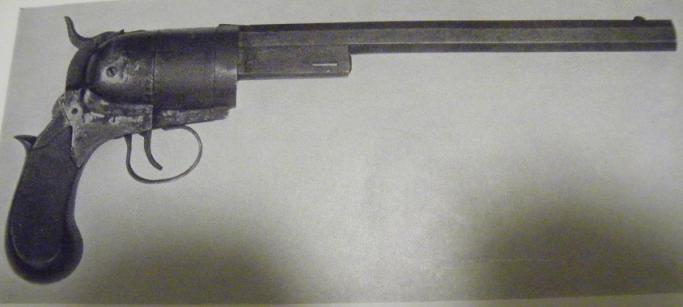
ONE OF SAMUEL COLT'S FIRST PROTOTYPES.
Probably made sometime between 1832 and 1835.
Note the folding trigger and folding bayonet blade.
When the hammer was cocked the trigger popped out.

Lacking funds, Colt engaged in various activities to earn money, including touring with a lecture show in which he used nitrous oxide "laughing gas" to entertain audiences, under the stage name of "Doctor Coult".
During his tour Chase continued development on Colt's design, and in 1832 Colt took his guns to the US Patent Office in Washington. His designs were granted US Patents in 1836, and establishing his life-long determination to protect his work, he'd patented the designs in France and England in 1835.
This was prescient, because as soon as the first Colt revolvers were seen in Europe copies or variations on Colt's design appeared. As he would for the rest of his life, Colt aggressively hunted down these patent violators and sued them out of business.
In March, 1836 Colt, along with investors formed the Patent Arms Manufacturing Company in Paterson New Jersey, and manufacture of the first Colt Paterson revolvers began. Colt was an employee of the company so he had limited input as to the operation. Although the name of the company was The Paterson Arms Company, the guns were widely known as Colt's revolvers.
Following what was to be his standard practice, Colt began immediately improving his design.
Also following a practice he would continue, Colt began to give lavishly engraved and decorated fancy guns to prominent people who might be of help in selling his guns.
Some of these early Paterson Colt's found their way to Texas where a revolt against the Mexican government was underway.
The Paterson Colt's found great favor among the Texas Ranger Frontier Battalion who used the revolvers to very good effect, especially in a running battle against Comanche Indians in 1844 during which the Rangers literally shot the Indians to a tatters with their Colt's.
With the investors in the Paterson Company quarreling, the high price of the guns, and the manufacturing situation confused, the Paterson Arms Company went bankrupt in 1842.
This would be the last time Samuel Colt would allow anyone but him to make decisions about his guns or his company.
Out of money, Colt once again began experimenting with under water mines and waterproof underwater cable.
Colt blew up a number of old ships using his cable and "torpedoes" and in 1844 Congress awarded Colt $15,000 to continue experimentation.
Colt would use his cable to lay the world's first underwater telegraph cable in New York harbor.
THE COLT WALKER
This was the gun that perfected the revolver as a practical arm.
The same action was used with little change up to the Colt Single Action Army of 1873.
It was a massive pistol, weighing 4 1/2 pounds, and until the development of the S&W .357 Magnum cartridge in the 1930's, it was the most powerful revolver in the world.
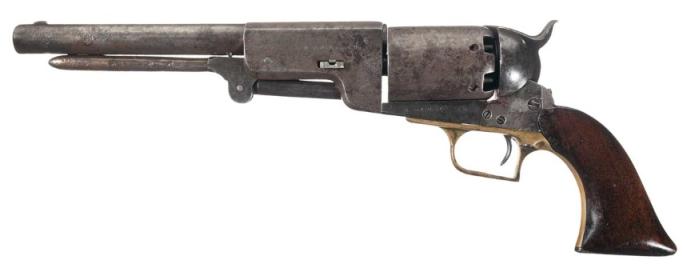
Sam Colt was more then a man who invented the revolver and made a fortune.
He was very much a man of the New England of his time, which was a hot bed of mechanical invention.
Most of this invention started in the gun making business, where the factories of the day were little more than an inventor/gunsmith and a handful of employees.
Samuel Colt changed all that. He was very much an inventor of machine tools and manufacturing processes for mass production of his revolvers.
Colt had a life-long desire to improve production and lower the cost of his guns, and he was a prime inventor of many of the machine tools that would be the basis for the American industrial revolution that far out classed the smaller European systems.
Colt and his employees invented mass production rifling machinery that would be the standard until after World War Two, and made early and major advances in lathes, power forges, profilers, and milling machines.
In order to increase production Colt combined his machinery with an enlightened treatment of his workers.
When Colt built a factory in London, all of Europe came to see it, and were shocked and astounded at a factory unlike anything they'd ever seen or imagined.
Instead of a few gunsmiths making a few guns at a time, the Colt factories were staffed by an army of workers, working in a forest of machine tools driven by a maze of belts powered by steam engines.
The majority of European factories were amateurish, small operations compared to Colt's huge and inventive factory.
From Colt's factories a tidal wave of the highest quality guns in the world poured forth.
Along with the other New England gun and tool makers, many of whom worked for Colt at some time, Colt invented the machinery and processes that would be used to make guns, then to make bicycles, which in turn made typewriters, farm equipment, and eventually were used by Henry Ford to build cars.
The massive flood of American produced guns, vehicles, and equipment that was used to equip the Allies during World War Two were made by machines that were largely invented by Sam Colt and his Yankee mechanic inventors.
In the case of the Colt Firearms Company, some of the machines that produced guns for World War Two were the same machines that had produced Colt's black powder revolvers and rifles during the Civil War.
The massive American industrial giant came about largely because Sam Colt wanted to build better, cheaper guns, faster.
In doing so, Samuel Colt built a company that's become an American legend.
THE LEGENDARY COLT SINGLE ACTION ARMY OF 1873.
Possibly the most recognizable handgun in the world.
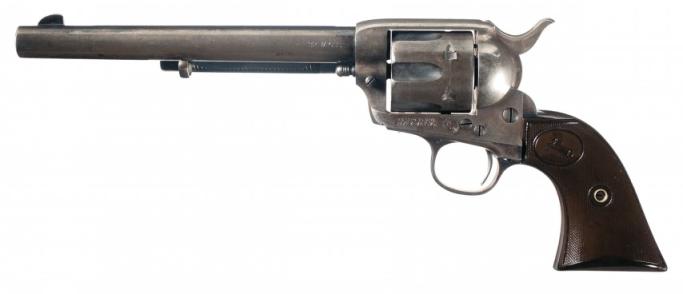
From the 1840's to 1985, Colt was THE supplier of guns, especially of handguns to the US government.
Colt's pistols began an enviable reputation starting with the Walker and Dragoon's, through the entire percussion revolver series, and cemented it indelibly with the Colt Single Action Army Model P of 1873.
Colt Firearms invented the modern double action, swing-out cylinder revolver in 1889, and entered a new century and a new legend with the Model of 1911 .45 Automatic which gained an unequaled reputation for reliability and power in the hands of men like Sergeant York.
From yet another expedition into Mexico with General Pershing, to the trenches of France, to the battlefields of WWII, Korea, and Vietnam, to the sands of the Mid-East, the 1911 served as America's fighting handgun.
In the early 21st Century the Colt 1911 .45 Automatic is again being bought by American Special Operations forces wanting a powerful, reliable pistol.
Famed writer and combat shooting innovator Colonel Jeff Cooper called the 1911 "The Hammer of the 20th Century" and it was just that.
THE COLT MODEL 1911 GOVERNMENT MODEL .45 AUTOMATIC
America was one of the first to arm it's military with an automatic pistol, and it was by far and away the best.
All it's contemporaries are long gone, but the Colt Automatic is more popular then ever.
Colonel Jeff Cooper called it "The Hammer of the 20th Century".
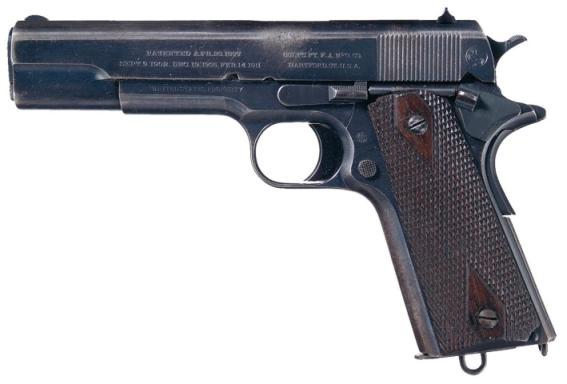
THE LEGENDARY COLT PYTHON
It was intended to be the finest revolver ever made in America and it was.
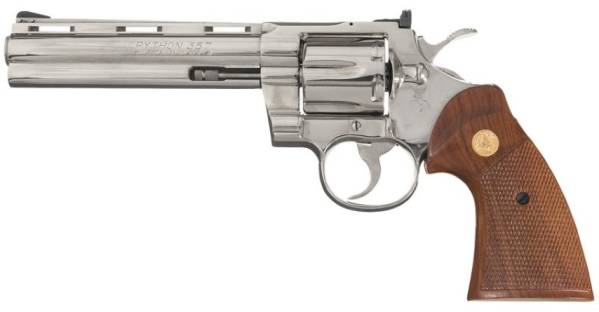
Falling on hard times, often self-induced, Colt Firearms went through some bad years but has begun to rebound in the early 21st Century under new management who are "gun people" instead of corporate executives with little interest or knowledge of guns.
Today, Colt Firearms is rebuilding it's reputation as one of America's premier gun makers, and is poised to again be a major player in the gun market.
What was started in the 1830's by a Yankee mechanic has truly become an American legend. The most collectable guns in the world are Colt guns, and Colt the most famous gun maker.
The list of Colt firearms and Colt users rings like a role call of American history.
SAMUEL COLT'S ORIGINAL HAND CARVED WOOD PROTOTYPE REVOLVER DESIGN
Carved while serving on the sailing ship Corvo.
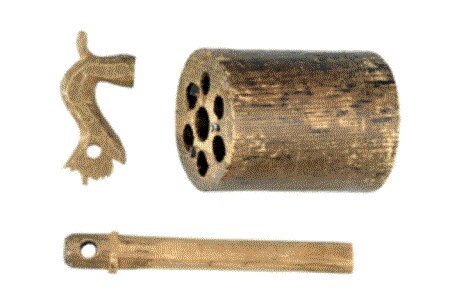
THE COCHRAN TURRET REVOLVER OF 1834.
A failed contemporary attempt at a revolver pistol.
Due to the likelihood of all the chambers "chain firing" at once, there was a near-certainty of shooting yourself.
Designing a practical revolver wasn't easy. Colt did it first.
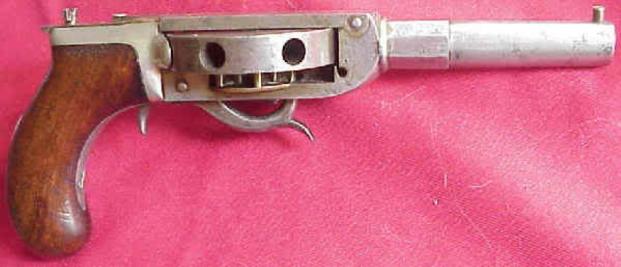
Colt never lost sight of his revolving cylinder gun idea and when he returned home from the voyage to Calcutta, he had gunsmith Anson Chase build him a prototype of his revolver idea sometime in 1831 and 1832 using his crude wooden models and some drawings.
This first experimental revolver revolved the cylinder when the hammer was cocked, but the cylinder lacked a locking system. This first gun exploded when Colt fired it because there were no separating partitions between the percussion caps and the gun "chain fired" all the chambers at once.
A second attempt was better and included a cylinder locking system and partitions between the percussion caps.
All the key points were present in this second prototype: A design with a single barrel in which cocking the hammer unlocked the cylinder, rotated it to the next chamber, relocked it, and left the hammer cocked and ready to fire with a press of the trigger.
THE PATERSON REVOLVER
Colt's first production revolver.
This revolver started the Colt legend and established the revolver as a viable arm.
The company failed, but Samuel Colt was on his way.
It was the Paterson revolver that the Texas Rangers used to such great effect before and during the Mexican War
and gave birth to the American Gunfighter.

In 1845 Mexico, dissatisfied with the results of the annexation of Texas began to dispute ownership of the Nueces River area, and war loomed.
General Zachary Taylor arrived in Texas with an army and Colt guns, having convinced the government to buy up every available Colt firearm that could be found, at the insistence of officers who'd seen them in combat in Texas.
The Texas Rangers enlisted in Taylor's army as The United States Mounted Rifles with Ranger Captain Jack Hays as Colonel. Hays was famous as the Ranger Captain who's Texas Ranger Frontier Battalion force of fourteen men engaged over eighty Comanche Indians and killed thirty-three of them using their 5-shot Paterson Colt's in 1844.
One of these volunteers was a young man named Samuel H. Walker.
Enlisted as a Captain, Walker and the Rangers were given priority of the issue of available Colt firearms, along with the Colt's they personally owned or were given by the Republic of Texas.
It was during this time that the Texas volunteers became known to the Mexicans as the Texas Devils due to their extreme violence against Mexicans, who the Texans hated for their brutal actions during the siege at the Alamo and the Goliad Massacre. The Ranger volunteers became well known for their rowdy behavior and violence, and a ready willingness to use their Colt's revolvers.
Leaving the army in 1846, Captain Walker went home to Maryland to recruit more volunteers, and during this visit, he went to see Sam Colt about getting more revolvers.
With the Paterson Arms Company out of business and lacking any examples of his own invention, Colt redesigned the gun from memory, making more improvements and incorporating many ideas from Walker who'd had actual combat experience with the Colt revolver.
With no factory to build his guns, Colt contracted Eli Whitney at his Whitneyville, Connecticut factory.
Colt and Whitney obtained a government contract to build 1,000 new improved Colt six shot revolvers along with accessories, at a price of $25.00 per gun and $3.00 for the accessories.
The contract was signed on January 4, 1847 and the new gun became the U.S. Model of 1847 Army Pistol, the first revolver ever adopted by a military.
After much difficulty with manufacturing problems and problems with government officials, the first Colt 1847 revolvers arrived in Mexico sometime in October.
A pair of the new revolvers had been personally sent to Captain Walker by Sam Colt, and Walker had them in his hands just four days before he was killed in action on October 9, 1847.
It was a huge and impressive weapon. Weighing four pounds, nine ounces, it had a nine inch barrel and was fifteen inches long overall.
Loaded with 50 grains of black powder behind a 220 grain conical bullet, the new revolver was the most powerful revolver made until the Smith & Wesson .357 Magnum of the 1930's.
Walker wrote Colt a letter in which he gave his impressions of the new revolver and his testing of it.
In his letter, Walker stated that the new Army revolver was "as effective as a common rifle at 100 yards, and superior to a musket at 200 yards".
Using his genius as a promoter of his guns, Colt named the Model of 1847 the Colt Walker in honor of Samuel Walker who'd done so much to make the new revolver a success.
This was to be quickly followed up with improved versions as the Colt First, Second, and Third Model Dragoon. These were improved and slightly smaller versions of the Walker, featuring a cylinder engraving of Captain Hays and his Rangers battling the Indians in the famous fight.
The Mexican War ended with a US victory and a peace treaty in February 1848.
By that time, Sam Colt was firmly in business, and his revolvers had earned a reputation such that anyone on the frontier would spend any amount of money to have at least one.
Colt established his own manufacturing plant in Hartford, and the Colt Patent Firearms Company was in business and soon into legend.
THE AMERICAN GUNFIGHTER
With the invention of Colt's revolver, the world saw something totally new: The American gunfighter.
Before the revolver, most handguns powerful enough for use in battle had been large single shots, which upon firing were discarded to allow use of the main weapon: the sword, which after 5,000 years was still the primary weapon of the warrior.
The invention of the Colt revolver instantly made the sword obsolete, but it remained a common weapon in the military up until World War One, mostly because men were reluctant to discard something that so identified the gentleman warrior. No less a gunman than George Patton was still playing with swords until just before World War Two.
Only in America were men so willing to discard the sword, to the point that after the Civil War, the sword totally disappeared in America except for the tradition-bound military.
After the 1850's, when an American reached for a sidearm it was usually a Colt's revolver.
With the Texas Devil Rangers, the American gunfighter was born on the Texas-Mexican border in the 1830's with a hail of bullets fired at the hated Mexicans.
He'd reach adulthood on the Missouri-Kansas border during the American Civil War of the 1850's and 1860's in the hands of Missouri Border Ruffians and Kansas Jayhawkers in a no-quarter bloody guerilla war fought with the Colt revolver as preferred weapon. The fact that the sword was now obsolete was learned the hard way in Missouri. Union cavalrymen learned that leading saber charges against gunfighters armed with revolvers was nothing short of suicide.
The gunfighter reached maturity on the Western frontier in the 1870's and 1880's, in the hands of cowboys, outlaws and lawmen and he'd almost always be armed with a Colt revolver.
This was virtually the first time since Robin Hood that a man was known more for his weapon then his actions.
It was primarily the Colt's revolver in the hands of gunfighters like the James and Younger brothers, Billy the Kid, The Earp brothers, James Butler "Wild Bill" Hickok, lawmen Heck Thomas, Chris Madsen, and Bill Tilghman, Butch Cassidy and the Hole in the Wall Gang, John Wesley Hardin, and Ben Thompson that established a reputation that would last to this day.
It can be said with more than a little truth that only Americans ever really understood the revolving pistol and how to use it. Other countries designed serviceable revolvers, notably the British with their Webley revolvers, but foreign revolvers seemed to lack a certain "rightness", and few foreigners ever gained the reputation of being a gunfighter.
COLT PROTOTYPE DOUBLE ACTION SWING-OUT CYLINDER REVOLVER OF 1884.
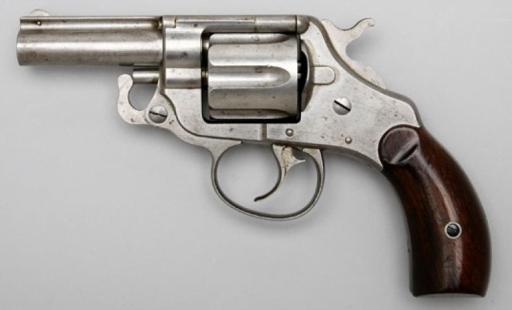
CYLINDER OF THE 1884 PROTOTYPE SWUNG OUT
This is not how it worked on the first production gun, the Model 1889 New Navy.
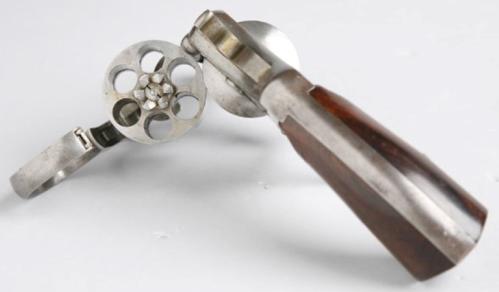
Colt continued it's legendary line of guns with such models as the Officer's Model target revolvers that so dominated the target matches from the early 1900's to the 1960's.
The famed Colt Detective Special was the sidearm of preference for off-duty police and detectives from 1927 to the 1970's, and the Colt Official Police was just that for a great many police departments and officers for much of the 20th Century.
The 1911 pistol was also a favorite of lawmen from the Texas Rangers to the FBI, and outlaws like John Dillinger and Bonnie and Clyde.
The fabled Colt Python set the standard for quality and the most accurate American revolver of all time.
The longest serving American service rifle is Colt's M16 series, which will be in use for the foreseeable future.
It's interesting that in the early 21st Century the most copied guns in the world are the Colt 1911 pistol and the Colt AR-15/M16 rifles. The majority of handgun makers in the world make a 1911 type pistol and producers of AR-15 type rifles are in the dozens.
The most recognized handgun in the world is the Colt Single Action. Show it almost anywhere on Earth and it's instantly identified as "the Cowboy gun".
The Colt percussion revolvers are being still produced as replicas over 130 years after the last were made by Colt.